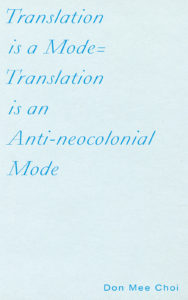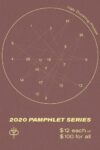
[Ugly Duckling Presse; 2020]
“Darkness to darkness, wound to wound, mirror to mirror, translation weaves,” writes Don Mee Choi in her 2016 essay, “Darkness — Translation — Migration.” This line, as a container of doubles, crossings and traversals, with translation as its thread, is reflected in her new essay: Translation is a Mode=Translation is an Anti-Neocolonial Mode. Reflecting this doubled title, Choi asserts her own doubled enunciation from the beginning of the piece: “I speak as a twin.” Working through images of twinned speech, mirrors, darkness, and the long wound of colonization and dislocation, Choi weaves an evocative exploration of thinking, writing, and decolonizing through translation.
Published as part of Ugly Duckling Presse’s 2020 Pamphlet Series, the essay theorizes translation — and by necessity, language itself — through diverse avenues: the continued U.S. military operations in Korea, Ingmar Bergman, migration, activism, and Choi’s own translation of the poet Kim Hyesoon. She deftly resituates canonical theories of translation into her own anti-neocolonial context. Choi speaks with and through many voices, from Walter Benjamin, Deleuze and Guattari, to Johannes Göransson. However, despite the number of elements it explores in a compact space, her writing manages to remain nimble in the connections it draws, never feeling bogged down in citation or references. The essay is a tightly woven crystallization of ideas that appear throughout Choi’s work — both in her translations and her own poetry — such as linguistic nonequivalence, the fraught link of nation and language, and one’s sense of home under neocolonization. Choi seamlessly moves between these ideas, drawing out their resonances through her sharply articulated attention.
The title, Translation is a Mode=Translation is an Anti-Neocolonial Mode, is itself a set of twins, as Choi immediately states at the beginning of the piece. The first half is taken from an English translation of Walter Benjamin’s canonical essay, “The Task of the Translator.” Choi writes that the second half, Translation is an Anti-neocolonial Mode, is a “retranslation, a radical hybrid of Benjamin’s brilliant concept and an anti-neocolonial stance I have come to choose over the past fifteen years of translating contemporary feminist Korean poetry.” The title therefore productively and suggestively alludes to the work of the essay, which finds the hinge between the theoretical and political practice of translation.
Throughout the essay, Choi reaches through the minute and specific into broad historical and political dimensions. One particularly brilliant instance builds from an oft-quoted moment from Benjamin’s essay, in which he discusses the word for bread in German brot and French pain. Choi adds the Korean ppang (빵) for bread to the list (which she notes is a “deformation” of the French pain) as a stepping stone to her discussion of cornbread, oksusuppang (옥수수빵). Choi writes into the space between cornbread and oksusuppang, showing how they divulge disparate “historical and political intentions.” Cornbread, she writes, “was intended as food aid from the US [after the Korean War.] So my tongue even before it had ever encountered the English language was a site of power takeover, war, wound, deformation, and, ultimately and already, motherless.” Choi resituates Benjamin’s discussion of the word for bread to allow for both the physical experience of language and what the word bread can mean in its specific political and geographical contexts. For Choi, language is never just language, but a way to traverse into the specificity of its speaker’s history and home. Cornbread for Choi also takes on the double signification as a physical craving and more ineffable feeling of longing, which she beautifully describes:
What makes oksusuppang, cornbread, most remarkable is not the seemingly benign humanitarian intention behind it, but the fact that on a local, bodily, tongue level, it creates an involuntary longing, a life-long craving, which could easily be translated as a desire to be colonized, and it certainly is translated this way at the level of US foreign policy, particularly at the level of military maneuvers. But my tongue deforms, it disobeys. I translate this longing, entangled with neocolonial dependency, as homesickness, which is a form of illness, a form of intensity.
Though the words seem to signify the same object, between cornbread and oksusuppang lie vastly different histories and resonances, which manifest in the mouth itself, the physical space of language production. This moment in the essay deftly converses with the history of theorizing through translation but roots it firmly in historical and material reality. Working doubly with Benjamin and the metaphor of the mother tongue, Choi evokes a scene of translation where the colonized position is one of ingesting homesickness, or longing, that cannot be detangled.
Choi also finds ways to depict translation beyond engaging with existing theoretical frameworks. She turns to images of translation that appear in Ingmar Bergman’s 1963 film The Silence, which “opens with a scene on a train in which Ester, an ill translator, coughs up blood. The boy is Johan, a son of Ester’s sister Anna, who is not a translator, and therefore not ill.” This continues Choi’s linking of homesickness, longing, and illness to translation as a practice of dislocation. But most importantly, the film becomes a way for Choi to discuss how mirrors act as sites of translation, or “deformation zones,” a term she borrows from Johannes Göransson’s text of the same name. In the film, foreign words appear on glass, characters speak in mirrors but are not heard or understood, and Ester, the translator, is often shown inhabiting the mirror. Choi explains: “It’s only natural that the translation is conducted in the mirror, for it is a site of various reflections, languages, a site where things are already mirrored, re-represented. . .” The mirror becomes the site of translation, a surface inhabited by doubles and twins.
What is most striking about Choi’s work is the way the images cascade outward: it is impossible to discuss just one instance of the mirror, for this moment is stacked on top of many images of mirrors, reflections, and deformations. Choi follows Bergman’s mirrors with a poem by Kim Hyesoon, a poet whose work she has frequently translated, and connects Bergman’s mirrors to the mirrors as they appear in Hyesoon’s poem “Memories of Giving Birth to a Daughter.” Then, Choi moves to mirrors as used in rituals in the Korean Shamanic tradition, which is followed by referencing an earlier exploration of the history of hangŭl: “In this zone of shamans, the lowly outsiders, the spoken and written hangŭl thrived. So Kim Hyesoon’s mirrors derive from a historically and linguistically expelled zone.” Finally, this leads her into a discussion of darkness: the darkness of shut eyes, the womb, closed mouths, and the darkness of the blackened manuscripts Kim Hyesoon edited and translated under military censorship. What starts as a simple reading of a mirrored translator in a film becomes a constellation of linking, active images. As in her work with Benjamin, Choi does not allow her images to remain in fixed, isolated spheres, but extends them outward, finding new reflections and further spaces of resonance.
Choi’s work also never dwells purely in the aesthetic or theoretical, instead, these realms necessarily open up to consider the politics of language. Translation, both its metaphors and practice, are linked to Choi’s own experiences of incomprehensibility and dislocation. She writes: “As a foreigner, as foreign words myself, I seek incomprehensibility — a mirror image of myself. I seek mirrors through which I can also traverse, in order to map out the neocolonial history of my home, to translate myself.” As readers, we encounter this neocolonial history in multiple ways throughout the essay. It is presented numerically, in the number of U.S. troops stationed in Korea (28,000), in years that the United States has had “temporary” military rule over Korea (since 1945), and in the number of military bases (almost 100). We encounter it in the names of U.S. and South Korean military exercises (such as Team Spirit and Strong Shield). We see it as well in her work interpreting South Korean activists as part of The Women’s Network Against Militarism.
One especially effective moment of permeability between the aesthetic and political occurs during her discussion of the Korean shamanic tradition as a space of gendered sociality. Choi describes it as “a place of women’s chorus (not to be confused with KORUS, which stands for Korea-US free trade agreement).” Here, Choi gestures doubly toward the impossibility of separating the political from the religious by rhetorically illustrating how language is mobilized for political means. The language of the U.S. military infiltrates religious spaces, even “a place of women’s chorus.” In its occupation of Korea, the language of the U.S. military is forever echoing: “My tongue and your tongue are already an aggregate, a site of multiple and collective enunciation,” she writes.
“I speak as a twin,” Choi ends the essay, but in this second enunciation, it carries the weight of many echoes. To speak as a twin is to speak with ingested longing and homesickness. It is to speak with the motherless, collective tongue of the neocolonial zone. It is to speak in the darkness of the mirror, to, in the words of Kim Hyesoon, “open this mirror and enter, / enter, and / enter again.” It is to cross, again and again, from darkness to darkness, wound to wound, mirror to mirror.
Blair Johnson is a poet and PhD candidate in English at the University at Buffalo. Her poems have appeared in Boston Review, DIAGRAM, and Best American Experimental Writing.
This post may contain affiliate links.







